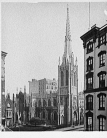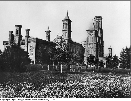
Grace Church
 Grace Church |
Chambers Street and Broadway became the location of the Sun Building, and later the first department store. The first fashion show in America was held there, and it had a beautiful show window. In 1682, Stewart had a yearly income of four million dollars. Mary Lincoln, the First Lady, owed Stewart $25,000 in 1865.
Duane's Farm became a department store. Duane Street is named after him. It had 900 seamstresses and grossed $10,000 a day.
 Wanamakers c.1903 (formerly Stewart's) |
At 33rd and 3rd Street they built a home for women, too expensive for people who worked. In 1878, feminists boycotted it.
A.T. Stewart is out of business for 12 years. John Wanamaker bought Stewart's when it went out of business. At the 9th Street Bridge, Wanamakers Place, there was a fire in 1956. Water flooded the subway station, and many firefighters died. Stewart's dead body was found and held for ransom at St. Marks in the Bowery. It was reinterred in Garden City, Long Island.
 The Castle at the Smithsonian |
123,000 people in New York were working on Wall Street in the mid-19th century. They lived in Soho and Greenwich Village. In 1846, a man in his 20s, James Renwick, built Grace Church. He later designed St. Patrick's Cathedral. He also designed the original building of the Smithsonian Institution in Washington, D.C. We also saw an original building, the hotel where Alexander Graham Bell first displayed his telephone. First came the residences, then the hotels, then the churches, and then the stores.
In 1848, cast iron architecture starts in NYC. Cast iron imitates stone - early cast iron, and glass windows. James McCreeries Fabrics building looks like it was carved by stone workers. It is an 150-year old building and looks brand new. Ms. Gold stuck a magnet to the building, just to prove what it is. Today the building is a co-op.
The first skyscraper in New York uses steel girders (1889). George P. Post was the architect who designed it. He was later the engineer for City College. The top, middle, and bottom were modeled after Classical Greek columns.
Steven Katz designed the Roosevelt Building on Broadway. It had an angled street roof. From 1900-1915 the Chelsea neighborhood was the capital of silent movies. "Cliffhangers" stated at Biograph Studios. The industry later moves to Hollywood, because of the weather and Thomas Edison. George M. Cohan wrote "Give my regards to Broadway, remember me to Herald Square, tell all the girls on 42nd Street, that I will soon be there." Ms. Gold recounted the move of the entertainment industry from 14th Street to Herald Square and 42 Street.
Third biggest transportation system was in NYC. That included the subways and buses. Labor unions started at Park Avenue and Broadway, and at 14th Street and Union Square, where we also saw new light fixtures made to look old, to enhance the area's historic dimension.
S. Klein's was the first budget store in town. There used to be signs in English, Italian, and Yiddish: "Punishment for theft is jail" It became a condominium, and houses the Israel Media Center.
 The Arch of Washington Square Park |
First Amalgamated Bank gave loans to working people. There was also a dormitory for NYU. A free bus takes students to the main campus at Washington Square.
We saw Heartland Pub and a boutique jewelry place. Ms. Gold pointed out a coffee shop. We went through a large greenmarket at Union Square. They sell goat cheese from 6000 goats - 4 days a week, 12 months a year.
There was also a statue of the Marquis de Lafayette. He was 19 when he came here to help during the Revolutionary War.
by Inge Levy